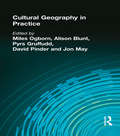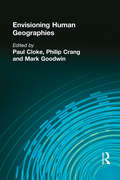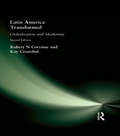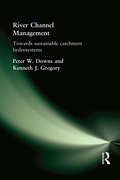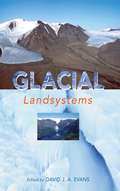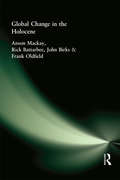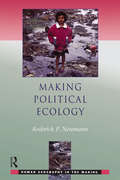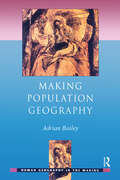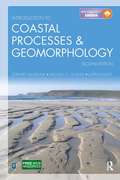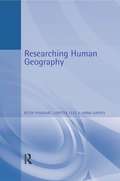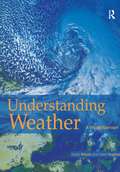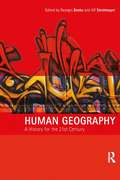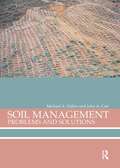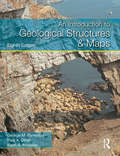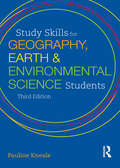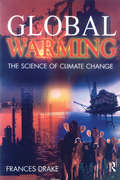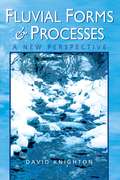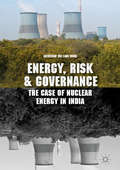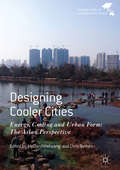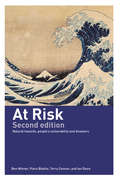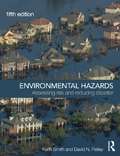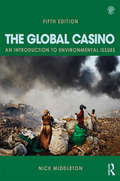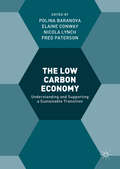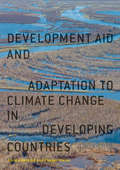- Table View
- List View
CULTURAL GEOGRAPHY IN PRACTICE
by Miles Ogborn Alison Blunt Pyrs Gruffudd David PinderCultural Geography in Practice provides an innovative and accessible approach to the sources, theories and methods of cultural geography. Written by an international team of prominent cultural geographers, all of whom are experienced researchers, this book is a fully illustrated guide to methodological approaches in cultural geography. In order to demonstrate the practice of cultural geography each chapter combines the following features:·Practical instruction in using one of the main methods of cultural geography (e.g. interviewing, interpreting texts and visual images, participatory methods)·An overview of a key area of concern in cultural geography (e.g. the body, national identity, empire, marginality)·A nuts and bolts description of the actual application of the theories and methods within a piece of researchWith the addition of boxed definitions of key concepts and descriptions of research projects by students who devised and undertook them, Cultural Geography in Practice is an essential manual of research practice for both undergraduate and graduate geography students.
Envisioning Human Geographies
by Paul J. ClokeBringing together many of the leading human geographers from around the English-speaking world, Envisioning Human Geographies offers a series of personal visions for the future of human geography. The result is a vigorous and far-sighted debate about what human geography could and should be concerned with in the twenty-first century.The individual contributors develop their arguments to address the shape and direction of human geographies, with each chapter looking forward and envisioning an intellectual future for the subject. The result is a set of powerful statements written around the themes of:·space·nature ·enclosure ·political-economy·non-representation ·post-colonialism ·feminism·post-structuralism ·computation·morality·spirituality ·activism. The statements are tied via an introduction that discusses the ideological, academic and aesthetic prompts that fire the human geographical imagination.Envisioning Human Geographies maps out important new territories of enquiry for human geography, and is essential reading for all students studying the nature and philosophy of the subject.
Latin America Transformed: Globalization and Modernity
by Robert N Gwynne Kay CristobalPraise for the first edition:'Accomplishes its task to provide readers with a broad multi-disciplinary view on globalization's many impacts on Latin America ... the organization of the collection is logical and thoughtful, and the structural perspectives offered are convincing and powerful. I recommend it to other Latin American social scientists.' Growth and Change 'An impressive, timely and lively volume, which is especially valuable for teaching purposes.' Journal of Latin American Studies'Authoritatively written by leading scholars in their respective fields.' AreaLatin America Transformed, 2nd Edition explains the region's economic, political, social and cultural transformations, its association with globalization and the search for modernity, and contributes to a greater understanding of how these transformations are affecting the people of Latin America.Using a political economy approach to unravel the concepts of globalization and modernity within Latin America, emphasis is placed on interpreting the macro-level structures that frame the transformations taking place. The book also investigates the dynamics of people's livelihoods as they make sense of, rework and live out these structural transformations. The international team of authors involved with the successful first edition have updated their focus and substantially rewritten their material to examine the challenges facing Latin America in the twenty-first century. Three completely new chapters have also been added. Latin America Transformed, 2nd Edition is now even more useful for undergraduate and postgraduate courses that examine economic, political, social and cultural change in Latin America.
River Channel Management: Towards sustainable catchment hydrosystems
by Peter Downs Ken GregoryRiver Channel Management is the first book to deal comprehensively with recent revolutions in river channel management. It explores the multi-disciplinary nature of river channel management in relation to modern management techniques that bear the background of the entire drainage basin in mind, use channel restoration where appropriate, and are designed to be sustainable.River Channel Management is divided into five sections: ·The Introduction outlines the need for river channel management .·Retrospective Review offers an overview of twentieth century engineering methods and the ways that river channel systems operate. ·Realisation explains how greater understanding of river channel adjustments, channel hazards and river basin planning created a context for twenty-first century management.·Requirements for Management explains and examines environmental assessment, restoration-based approaches, and methods that work towards 'design with nature'·Final Revision speculates about prospects for twenty-first century river channel management. River Channel Management is written for higher-level undergraduates and for postgraduates in geography, ecology, engineering, planning, geology and environmental science, for professionals involved in river channel management, and for staff in environmental agencies.
GLACIAL LANDSYSTEMS
by David Evans Liz GoosterThis book is a comprehensive overview of the ever-captivating field of glaciation from the perspective of glacial landsystems. This approach models the many processes, forms and interactions that can be found in glaciated landscapes throughout the world. Landsystems models allow the glacial geologist and geomorphologist to evaluate these landscapes in relation to the dynamics of glaciation and to climate and geology. Glacial Landsystems brings together the expertise of an international range of specialists to provide an up-to-date summary of landsystems relevant to both modern and ancient glacier systems and also in the reconstruction and interpretation of former glacial environments. The models are applicable at all scales from ice sheets to small valley glaciers.This book is an essential reference for anyone embarking upon research or engineering surveys in glaciated basins and provides a wide-ranging handbook of glacial landsystem types for students of glaciation.
Global Change in the Holocene
by John Birks Rick Battarbee Anson Mackay Frank OldfieldThe Holocene spans the 11,500 years since the end of the last Ice Age and has been a period of major global environmental change. However the rate of change has accelerated during the last hundred years, due largely to human impacts and this has led to a growing concern for the future of our environmental resources. Global Change in the Holocene demonstrates how reconstructing the record of past environmental change can provide us with essential knowledge about how our environment works and presents the reader with an informed viewpoint from which to project realistic future scenarios. The book brings together key techniques that are widely used in Holocene research, such as radiocarbon dating, dendrochronology and sediment analysis and offers a comprehensive analysis of various archives of environmental change including instrumental and documentary records, corals, lake sediments, glaciers and ice cores. This reference will be an informative and cutting-edge resource for all researchers in the fields of climate change, environmental science, geography, palaeoecology and archaeology.
Making Political Ecology
by Rod NeumannMaking Political Ecology presents a comprehensive view of an important new field in human geography and interdisciplinary studies of nature-society relations. Tracing the development of political ecology from its origins in geography and ecological anthropology in the 1970s, to its current status as an established field, the book investigates how late twentieth-century developments in social and ecological theories are brought together to create a powerful framework for comprehending environmental problems.Making Political Ecology argues for an inclusionary conceptualization of the field, which absorbs empirical studies from urban, rural, First World and Third World contexts and the theoretical insights of feminism, poststructuralism, neo-Marxism and non-equilibrium ecology. Throughout the book, excerpts from the writings of key figures in political ecology provide an empirical grounding for abstract theoretical concepts.Making Political Ecology will convince readers of political ecology's particular suitability for grappling with the most difficult questions concerning social justice, environmental change and human relationships with nature.
Making Population Geography
by Adrian BaileyMaking Population Geography is a lively account of the intellectual history of population geography, arguing that, while population geography may drift in and out of fashion, it must continue to supplement its demographic approach with a renewed emphasis on cultural and political accounts of compelling population topics, such as HIV-AIDS, sex trafficking, teen pregnancy, citizenship and global ageing, in order for it to shed light on contemporary society. Making Population Geography draws both on the writings of those like Wilbur Zelinsky and Pat Gober who were at the very epicentre of spatial science in the 1960s and those like Michael Brown and Yvonne Underhill-Sem whose post-punk introspections of method, content and purpose, now push the field in new directions. Using a wide range of case studies, contemporary examples and current research, the book links the rise and fall of the key concepts in population geography to the changing social and economic context and to geographys turn towards social theory. Referencing the authors classroom experiences both in the US and the UK, Making Population Geography will appeal to students studying geography, population issues and the development of critical scholarship.
Introduction to Coastal Processes and Geomorphology, Second Edition
by Gerd Masselink Michael Hughes Jasper KnightThe world's coastlines represent a myriad of dynamic and constantly changing environments. Heavily settled and intensely used areas, they are of enormous importance to humans and understanding how they are shaped and change is crucial to our future.Introduction to Coastal Processes and Geomorphologybegins by discussing coastal systems and shows how these systems link to the processes examined in detail throughout the book. These include the morphodynamic paradigm, tides, waves and sediment transport. Later chapters explore fluvial deltas, estuaries, beaches and barriers, coastal sand dunes and geologically-influenced coasts such as cliffs, coral reefs and atolls. A new chapter addresses the forward-facing aspect of coastal morphodynamics, including the ways in which coasts respond to rapid climate changes such as present day global warming. Also new to this second edition is a chapter on future coasts which considers the wider effects of coastal change on other important aspects of coastal systems, including ecology, management, socio-cultural activities, built and natural heritage, and archaeology. Case studies using examples from around the world illustrate theory in practice and bring the subject to life. Each chapter starts by outlining the 'aims' and questions at the end allow you to track your progress. This book is accompanied by additional resources online at www.hodderplus.com/geography including: Answers to the questions available to download as MP3 files Expanded case studies with colour photos, links to relevant websites and a map link to pinpoint the case study location Interactive multiple choice questions and worked examplesThe ebook edition is in VitalBookTM Bookshelf - an ebook reader which allows you to:download the ebook to your computer or access it anywhere with an internet browser search the full text of all of the ebooks that you hold on your bookshelf for instant access to the information you needmake and share notes and highlights on your ebookscopy and print text and figurescustomize your view by changing font size and layout.
Researching Human Geography
by Anna Davies Keith Hoggart Loretta LeesResearching Human Geography is an essential new text for any geography student about to embark on a research project. An understanding of how different theories of knowledge have influenced research methodologies is crucial in planning and designing effective research; this book makes this link clear and explores how various philosophical positions, from positivism to post-structuralism, have become associated with particular methodologies.The book gives an overview of a wide range of methods and data collection, both quantitative and qualitative, and explores their strengths and weaknesses for different kinds of research. 'Researching Human Geography' also looks at the various techniques available for the analysis of data, which is presented as an integral and ongoing part of the research process. Clearly written, with extensive use of examples from previous research to show 'methodology in action', this new text is an invaluable addition to both the theory and method of research in human geography.
Understanding Weather
by Karel Karel Hughes Julian MayesWeather provides a wide variety of stimuli for our senses. The sound of thunder and gales, the smell of damp soil at the start of a summer thunderstorm are but temporary phenomena while the visual panorama of the changing sky that provides a more revealing insight into the workings of the dynamic atmosphere. Understanding Weather shows how it is possible to understand weather and climate by combining our ability to observe weather systems from the earth's surface with visualisation from above - notably by means of satellite imagery. This fusion of human observation with the contrasting capabilities of remote sensing gives us a new perspective for exploring the three dimensional atmosphere. Remote sensing imagery and real-time weather information are now widely available through the internet, allowing the reader to relate the case studies to today's weather situation.As with all sciences, understanding starts with careful observation. This books aims to show that it is possible to analyse global weather systems through a visual approach rather than the traditional use of mathematics and physics. After examining the interaction of atmospheric heat, moisture and motion in a non-technical style, the contrasting but complementary techniques of weather observation from 'below' and 'above' are compared. The world's climates are then surveyed with key weather features illustrated by satellite imagery, highlighting the way in which weather events may develop into atmospheric hazards.
Human Geography: A History for the Twenty-First Century
by George Benko'Human Geography' examines the major trends, debates, research and conceptual evolution of human geography during the twentieth century. Considering each of the subject's primary subfields in turn, it addresses developments in both continental European and Anglo-American geography, providing a cutting-edge evaluation of each.Written clearly and accessibly by leading researchers, the book combines historical astuteness with personal insights and draws on a range of theoretical positions. A central theme of the book is the relative decline of the traditional subdisciplines towards the end of the twentieth century, and the continuing movement towards interdisciplinarity in which the various strands of human geography are seen as inextricably linked.This stimulating and exciting new book provides a unique insight into the study of geography during the twentieth century, and is essential reading for anyone studying the history and philosophy of the subject.
Soil Management: Problems and Solutions
by Michael A Fullen John A CattThe soil is a fundamental constituent of the Earth's system, maintaining a careful state of equilibrium within the biosphere. However, this natural balance is being increasingly disturbed by a variety of anthropogenic and natural processes, leading to the degradation of many soil environments. Soil Management provides a comprehensive and authoritative introduction to the many problems, challenges and potential solutions facing soil management in the twenty-first century. Covering a range of topics, including erosion, desertification, salinization, soil structure, carbon sequestration, acidification and chemical pollution, the book also develops a prognosis for the future of soil management in the face of growing populations and global warming.Written with the needs of students in mind, each chapter provides a broad overview of a problem, analyses approaches to its solution and concludes with references and suggestions for further reading. Soil Management will be of great value to environmental science and geography undergraduates taking soil management courses in their second or third year.
An Introduction to Geological Structures and Maps, Eighth Edition
by George M Bennison Paul A Olver Keith A MoseleyAn Introduction to Geological Structures and Maps is a concise and accessible textbook providing simple structural terminology and map problems which introduce geological structures. It is a perfect introduction to mapping for students of geology, engineering geology and civil engineering.Each topic is explained and illustrated by figures, and exercises follow on successive maps. If students are unable to complete an exercise, they can read on to obtain more specific instructions on how theory may be used to solve the problem. An appendix at the end of the book provides the solutions.This new, eighth edition contains simplified introductory matter to make the subject as easy to grasp as possible. Colour photographs illustrating geological structures bring the subject to life and a new map from the British Geological Survey illustrates a real area. There is more on outcrop patterns, which will help students to think in 3D, and on structures and the relationship of topography to geological structure. Cliff sections have been added to reinforce the concept of apparent dip. The section on planetary geology has been more closely tied to igneous geology to aid understanding of the connection between the two. Finally, a new map on economic geology has been added for the benefit of engineering students.A geological glossary helps students to understand and memorise key terms and a new, colourful, text design enlivens the appearance of this popular book.
Study Skills for Geography, Earth and Environmental Science Students
by Pauline E KnealeThere are moments in everyone's degree when you are expected to do something unfamiliar and daunting - present a seminar, go on a fieldtrip, create a wiki page, lead a lab team - and how to do it or what to expect is unclear. Studying at university requires a different approach from studying at school and this book explains this transition. Packed with practical hints, study tips, short cuts, real-life examples and careers advice, this book will prove invaluable throughout your geography, earth science or environmental science degree. Designed for all geography, earth science and environmental science students, this book provides guidance on: time management and effective research constructing essays and creating arguments giving presentations confidently undertaking fieldwork and laboratory work avoiding plagiarism and citing references correctly using e-technologies such as blogs and your university's VLE online assessment and peer feedback. This guide also explains the role of the academic and how it differs from that of a school teacher, and prepares you for the world of work by showing how the skills you learn at university today can be used in your career choice of tomorrow.
Global Warming
by Frances DrakeFirst published in 2000. Routledge is an imprint of Taylor & Francis, an informa company.
Fluvial Forms and Processes: A New Perspective
by David KnightonDavid Knighton's best-selling book looks at the wide range of forms developed by natural rivers and the processes responsible for that development. The book combines empirical and theoretical approaches, and provides a critical assessment of the many schools of thought which have emerged for dealing with adjustment in the fluvial system. It is fully illustrated throughout by a superb range of figures, photographs and tables.Starting with the network scale, the book examines the interaction of hillslopes, drainage networks and channels, and goes on to considerations of catchment hydrology and catchment denudation. Fluvial processes are analysed in detail, from the mechanics of flow to sediment transport and deposition. Detailing the major components of river channels, the book examines the nature of river adjustment, particularly with respect to equilibrium concepts, and concludes with a look at channel changes through time, affected by flood discharges, climatic change and human activities.
Energy, Risk and Governance: The Case of Nuclear Energy in India
by Catherine Mei WongThis book is about how energy, risk and governance are intertwined in the development of the nuclear industry in India and its relationship with the Indian public. It provides a rare insider-view of how the nuclear establishment thinks about risk, contrasted with public understandings of nuclear risk.Energy, Risk and Governance presents a nuanced picture of why nuclear energy is still considered by some as a rational choice. This is in spite of its risks, the ambiguities in both expert and public risk perceptions, and the internal reflexivities that have emerged within the nuclear establishment as a result of the Fukushima-Daiichi disaster that is absent from public discourse. The insights in this book are not unique to India and similar observations can likely be made across the global nuclear industry.Reflecting on what this means for risk governance in practice, this book proposes practical suggestions and some tools that practitioners in the nuclear industry can use in public engagement, risk communication and deliberation at various stages of decision-making.
Designing Cooler Cities: The Asian Perspective (PDF)
by Ali Cheshmehzangi Chris ButtersThis edited book surveys the major sustainability challenges facing Asian cities, in particular those related to urban energy and city cooling. The book discusses the key concepts and issues involved, addressing the three levels of micro (individual buildings), meso (neighbourhoods/districts) and macro (whole or large parts of cities). It illustrates different paradigms of urban development and explores how to create cooler cities by applying integrated sustainable design and planning on all three levels, bridging the gap between specialist approaches by highlighting both built projects, processes, and research. It also raises questions about prevalent paradigms of urban development as well as topics relating to urban district cooling solutions, sustainable construction materials, and processes towards effective delivery of sustainable cities. Providing cutting edge insights into hot climate cities in Asia, this text is also pertinent for the study of cities in other world regions, notably in developing countries, and of broad relevance to sustainable urban planning in all contexts.
At Risk: Natural Hazards, People's Vulnerability and Disasters (PDF)
by Piers Blaikie Terry Cannon Ian Davis Ben WisnerThe term 'natural disaster' is often used to refer to natural events such as earthquakes, hurricanes or floods. However, the phrase 'natural disaster' suggests an uncritical acceptance of a deeply engrained ideological and cultural myth. At Risk questions this myth and argues that extreme natural events are not disasters until a vulnerable group of people is exposed. The updated new edition confronts a further ten years of ever more expensive and deadly disasters and discusses disaster not as an aberration, but as a signal failure of mainstream 'development'. Two analytical models are provided as tools for understanding vulnerability. One links remote and distant 'root causes' to 'unsafe conditions' in a 'progression of vulnerability'. The other uses the concepts of 'access' and 'livelihood' to understand why some households are more vulnerable than others. Examining key natural events and incorporating strategies to create a safer world, this revised edition is an important resource for those involved in the fields of environment and development studies.
Environmental Hazards: Assessing Risk and Reducing Disaster (PDF)
by Keith SmithThe expanded fifth edition of Environmental Hazards provides a balanced overview of all the major rapid-onset events that threaten people and what they value in the twenty-first century. It integrates cutting-edge material from the physical and social sciences to demonstrate how natural and human systems interact to place communities of all sizes, and at all stages of economic development, at risk. It also shows how the existing losses to life and property can be reduced. Part I of this established textbook defines basic concepts of hazard, risk, vulnerability and disaster. Critical attention is given to the evolution of theory, to the scale of disaster impact and to the various strategies that have been developed to minimise the impact of damaging events. Part II employs a consistent chapter structure to explain how individual hazards, such as earthquakes, severe storms, floods and droughts, plus biophysical and technological processes, create distinctive patterns of loss throughout the world. The ways in which different societies make a positive response to these threats are placed in the context of ongoing global change. In this extensively revised edition: An entirely new and innovative chapter explains how modern-day complexity contributes to the generation of hazard and risk Additional material supplies fresh perspectives on landslides, biophysical hazards and the increasingly important role of global-scale processes The increased use of boxed sections allows a greater focus on significant generic issues and offers more opportunity to examine a carefully selected range of up-to-date case studies Each chapter now concludes with an annotated list of key resources, including further reading and relevant websites. Environmental Hazards is a well-written and generously illustrated introduction to all the natural, social and technological events that combine to cause death and destruction across the globe. It draws on the latest research findings to guide the student from common problems, theories and policies to explore practical, real-world situations. This authoritative, yet accessible, book captures both the complexity and dynamism of environmental hazards and has become essential reading for students of every kind seeking to understand the nature and consequences of a most important contemporary issue.
The Global Casino, Fifth Edition: An Introduction to Environmental Issues (PDF)
by Nick MiddletonThe Global Casino is an introduction to environmental issues which deals both with the workings of the physical environment and the political, economic and social frameworks in which the issues occur. Using examples from all over the world, the book highlights the underlying causes behind environmental problems, the human actions which have made them issues, and the hopes for solutions. It is a book about the human impact on the environment and the ways in which the natural environment impacts human society. The fifth edition has been fully revised and updated throughout, with new case studies, figures, and online resources such as downloadable figures and tables from the text and multiple choice questions for students, accessible at: www. routledge. com/cw/middleton. New topics covered in extended boxed case studies include payment for environmental services, ocean acidification, biofuels in Brazil, waste reduction through industrial symbiosis, and the long-term impact of natural disasters on vulnerable groups. Other approaches and concepts covered for the first time in this new edition include traditional ecological knowledge, environmental justice, the 'resource curse', and urban biodiversity. Eighteen chapters on key issues follow three initial chapters which outline the background contexts of the physical and human environments and the concept of sustainable development. Each chapter provides historical context for key issues, outlines why they have arisen, and highlights areas of controversy and uncertainty to appraise how issues can be resolved both technically and in political and economic frameworks. Each chapter also contains an updated critical guide to further reading and websites, as well as discussion points and essay questions. The text can be read in its entirety or individual chapters adopted as standalone reading. The Global Casino is an essential resource for students of the environment, geography, earth sciences and development studies. It provides comprehensive and inspirational coverage of all the major global environmental issues of the day in a style that is clear and critical.
Revise Edexcel GCSE (9-1) Geography A: Revision Guide (PDF)
by Michael ChilesOur revision resources are the smart choice for those revising for Edexcel GCSE (9–1) Geography A.
The Low Carbon Economy: Understanding and Supporting a Sustainable Transition (PDF)
by Polina Baranova Elaine Conway Nicola Lynch Fred PatersonThis edited collection explores the challenges and opportunities presented by the transition to a low carbon economy, and outlines the different approaches taken to ensure the sustainability of such a transition. Chapters explore the nature of the transformation from a ‘brown’ to ‘green’ economy, the importance of effective carbon measurement and management methodologies, the use of behaviour economics, and the application of a growth-enabling approach. Offering valuable insights into how various stakeholders respond to the challenges of green growth and focusing in particular on the support of universities, The Low Carbon Economy covers themes of leadership, systems approach, stakeholder management, and collaborative action. This comprehensive study provides readers with constructive ideas for maximising the opportunities of transitioning to a low carbon economy, and will serve as a useful tool for practitioners and academics interested in sustainability.
Development Aid and Adaptation to Climate Change in Developing Countries
by Carola Betzold Florian WeilerThis book examines development aid for climate change adaptation. Increasing amounts of aid are used to help developing countries adapt to climate change. The authors seek to discover how this aid is distributed and what constitutes the patterns of adaptation-aid giving. Does it help vulnerable countries, as donors promise, or does it help donors achieve economic and political gains? Set against the backdrop of international climate change negotiations and the aid allocation literature, Betzold and Weiler’s empirical analysis proceeds in three steps: firstly they assess adaptation aid as reported by the OECD, then statistically examine patterns in adaptation aid allocation, and finally qualitatively investigate adaptation aid in three large climate donors: Germany, Sweden and the United Kingdom. With its mixed-method research design and comprehensive data, this work provides a unique, state-of-the-art analysis of adaptation aid as a new stream of development aid.
